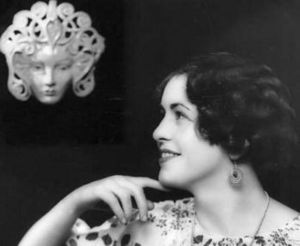Marguerite Mahood facts for kids
Quick facts for kids
Marguerite Mahood
|
|
|---|---|
 |
|
| Born |
Margerite Henriette Callaway
1901 |
| Died | 1989 Toorak, Victoria
|
| Nationality | Australian |
| Education |
|
| Alma mater | University of Melbourne |
| Known for | Pottery, ceramics, political caricatures |
| Spouse(s) |
Thomas Orrock George Mahood
(m. 1923) |
Marguerite Mahood (born Callaway) was a super talented Australian artist. She was great at many things: drawing, making pottery, sculpting, writing books, and even studying history! Marguerite wrote lots of articles for a magazine called The Australian Home Beautiful. She also helped start many important art groups in Australia.
Contents
Marguerite's Early Life and School Days
Marguerite Henriette Callaway was born on July 29, 1901. Her birthplace was Richmond, Victoria, in Australia. She was the oldest of four children.
Marguerite went to Presbyterian Ladies' College, Melbourne for school. After that, she studied drawing at the National Gallery of Victoria Art School. This school is now called the Victorian College of the Arts. She learned from famous artists like Frederick McCubbin.
In the 1930s, Marguerite took more art classes. She studied at the Working Men's College, Melbourne, which is now RMIT University. She also learned from artist Leslie Wilkie.
In 1923, Marguerite married Thomas Orrock George Mahood. He was an engineer.
Marguerite's Amazing Art Career
Marguerite Mahood first showed her art in 1925. She exhibited cool linocut prints with the Victorian Artists' Society.
Pioneering Radio and Pottery
In 1926, Marguerite became one of Australia's first women to host her own radio show! She talked about art and architecture every week. This was on a radio station that later became the ABC.
Marguerite became very famous for her pottery. Her ceramic pieces had beautiful, bright glazes. They often featured detailed patterns. She also made funny and playful ceramic items. These pieces were very popular and helped her become well-known.
Marguerite wanted her pottery to be special. She made unique pieces that couldn't be mass-produced. She created many "double-filigree" items. These were so tricky that few other artists could copy them.
Exhibitions and Recognition
In 1932, Marguerite had a very successful art show. It was at Everyman's Library. Because of this, the well-known Sedon Galleries asked her to exhibit there. From 1932 to the 1950s, her art shows always got great reviews.
Her work was even included in The Story of Australian Art (1934). This was the first big book about Australian art.
Helping Other Artists
Marguerite was a founding member of two important groups. These were the Australian Ceramic Society and the Victorian Sculptors’ Society. She also wrote articles for The Australian Home Beautiful magazine. In these articles, she gave tips to people who wanted to try pottery. She especially encouraged women. She also wrote about the history of pottery and supported the Australian ceramics industry.
After her son Martin was born in 1938, Marguerite made less pottery. New art styles and home decorating trends also changed. She decided to stop making ceramics. But she kept creating art! She made sculpted metal works. Later in life, she focused on beautiful linoprints of animals.
Later Career and Life
In the 1940s and 1950s, Marguerite ran a screenprinting business. She also became a popular children's cartoonist. She wrote and illustrated books like The Whispering Stone: An Australian Nature Fantasy (1944). She also wrote Drawing Australian Animals (1952).
Drawing Animals and Studying History
After 1950, Marguerite wrote for Wild Life magazine. Her series "How to Draw Australian Animals" came from this work. The Audubon Society of Canada even asked her to create a similar series for Canadian animals! She published several children's books.
Marguerite went back to university as an adult. She earned a Master of Arts degree in 1965. Then, in 1970, she got a PhD in history from the University of Melbourne. Her PhD paper was published as a book in 1973. It was called The Loaded Line: Australian Political Caricature 1788 – 1901.
Marguerite believed that newspaper cartoons showed what everyday people thought about history. She developed this idea in her studies. Her book, The Loaded Line, is now a very important study of Australian cartoons. It's the best guide to Australian political cartoons up to 1901. Marguerite became a top expert on early Australian cartoonists. She kept working in this field even when she was in her eighties!
Marguerite Mahood's collection of works is kept at the Women's Art Register in Melbourne. While only one museum bought her ceramics when she was alive, her art is now in many collections. You can find her work in regional, state, national, and even international museums.
Marguerite's Passing
Marguerite Mahood passed away on October 14, 1989. She died in Toorak, Victoria, Melbourne. She is remembered by her son and two grandsons.
Exhibitions
- November 1932: Solo exhibition at Everyman's Library
- November 1933: Solo exhibition at Everyman's Library
- 19–30 November 1933: Solo exhibition at Sedon Galleries
- 23 November - 5 December 1936: Exhibition at Hogan Gallery
- March 1947: Solo exhibition at David Jones' Gallery
- 17–23 October 1997: From the Earth I Arise: The Ceramics of Marguerite Mahood, Ballarat Fine Art Gallery

